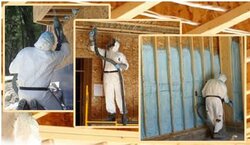Hello
Mike Holmes contractors -- see http://beyondfoam.com/
http://beyondfoam.com/
"Because poor quality work can lead to costly problems such as leaks, fungal growth, poor and costly holes in the insulation barrier" Can good installation work prevent this??
Also if the there is a contaminate on the wood foam's adhesion can be compromised over time. So in older homes the foam may pull away from the wood and moisture can get trapped.
Has anyone had these Spray Foam insulation issues??
Think about the issue below, luckily it is low voltage cat 5. What about high voltage 110 or 220 wiring that can cause a fire!!
Below is the ECO blue Walltite by BASF that is seen on Holmes on Homes that shorts out wiring!
http://www.avsforum.com/avs-vb/archive/index.php/t-832496.html
ddingle
04-10-07, 08:19 PM
Anyone ever seen spray foam insulation damage wire? The only unusual thing was the fact that they sprayed the attic as well as the outside walls. We are in Minnesota, so insulation is important. We found shorted cat 5 wiring in three different attic locations. We found the damage buried about 8 to 10 inches in the attic foam.
Obviously the foam dries around the wire and is hot when sprayed. The damage looked like the internal conductors got hot for about a foot length of the wire,melting the insulation,but not the outer jacket. Everything else looks OK.
It seemed stretched out as well. Anyone had any problems like this?Or have any insight?
Belden hasn't any record of issues with foam.
Demilec Sealection 500 product has off-gassing from the chemical that may never go away even after removal!!
See below—Off Gases that do not go away!
http://www.greenbuildingadvisor.com...9/odor-problem-attic-after-spray-foam-applied
That is why I like Reflectix Foil, Roxul or the Pink Panther Stuff!!
http://www.roxul.com/residential/save+energy+with+comfortbatt
What is R-value of Roxul?
R-value is the measurement of an insulation’s ability to prevent heat flow. The higher the R-value, the more insulating power it provides. Roxul ComfortBatt delivers top performance for all thermal applications around the home. It is available in the following sizes:
3½†thick batts with R-value ratings of R14 and R15 (US only) for use in 2 x 4 exterior wall applications.
5½†thick batts with R-value ratings of R22 and R23 (US only) for insulating attics and 2 x 6 framed exterior walls.
7¼†think batts with R-value rating of R28 and R30 (US only) for insulating attics and 2 x 8 framed exterior walls.
Equally important, the R-value of Roxul insulation is not affected by water. Roxul ComfortBatt™ does not store or transfer moisture, and it’s completely resistant to mold, mildew, rot and bacterial growth.
Is spray foam toxic? Look at the suits they are wearing! That is a good clue!
Also when there is a fire, the Toxic fumes are really deadly!
Is that why there are no Fire Toxic Tests on their product and they just say smoke from wood can kill too!
Smoke from wood will not kill if you get out in time and only breath some!!
Mike Holmes contractors -- see
 http://beyondfoam.com/
http://beyondfoam.com/"Because poor quality work can lead to costly problems such as leaks, fungal growth, poor and costly holes in the insulation barrier" Can good installation work prevent this??
Also if the there is a contaminate on the wood foam's adhesion can be compromised over time. So in older homes the foam may pull away from the wood and moisture can get trapped.
Has anyone had these Spray Foam insulation issues??
Think about the issue below, luckily it is low voltage cat 5. What about high voltage 110 or 220 wiring that can cause a fire!!
Below is the ECO blue Walltite by BASF that is seen on Holmes on Homes that shorts out wiring!
http://www.avsforum.com/avs-vb/archive/index.php/t-832496.html
ddingle
04-10-07, 08:19 PM
Anyone ever seen spray foam insulation damage wire? The only unusual thing was the fact that they sprayed the attic as well as the outside walls. We are in Minnesota, so insulation is important. We found shorted cat 5 wiring in three different attic locations. We found the damage buried about 8 to 10 inches in the attic foam.
Obviously the foam dries around the wire and is hot when sprayed. The damage looked like the internal conductors got hot for about a foot length of the wire,melting the insulation,but not the outer jacket. Everything else looks OK.
It seemed stretched out as well. Anyone had any problems like this?Or have any insight?
Belden hasn't any record of issues with foam.
Demilec Sealection 500 product has off-gassing from the chemical that may never go away even after removal!!
See below—Off Gases that do not go away!
http://www.greenbuildingadvisor.com...9/odor-problem-attic-after-spray-foam-applied
That is why I like Reflectix Foil, Roxul or the Pink Panther Stuff!!
http://www.roxul.com/residential/save+energy+with+comfortbatt
What is R-value of Roxul?
R-value is the measurement of an insulation’s ability to prevent heat flow. The higher the R-value, the more insulating power it provides. Roxul ComfortBatt delivers top performance for all thermal applications around the home. It is available in the following sizes:
3½†thick batts with R-value ratings of R14 and R15 (US only) for use in 2 x 4 exterior wall applications.
5½†thick batts with R-value ratings of R22 and R23 (US only) for insulating attics and 2 x 6 framed exterior walls.
7¼†think batts with R-value rating of R28 and R30 (US only) for insulating attics and 2 x 8 framed exterior walls.
Equally important, the R-value of Roxul insulation is not affected by water. Roxul ComfortBatt™ does not store or transfer moisture, and it’s completely resistant to mold, mildew, rot and bacterial growth.
Is spray foam toxic? Look at the suits they are wearing! That is a good clue!
Also when there is a fire, the Toxic fumes are really deadly!
Is that why there are no Fire Toxic Tests on their product and they just say smoke from wood can kill too!
Smoke from wood will not kill if you get out in time and only breath some!!


